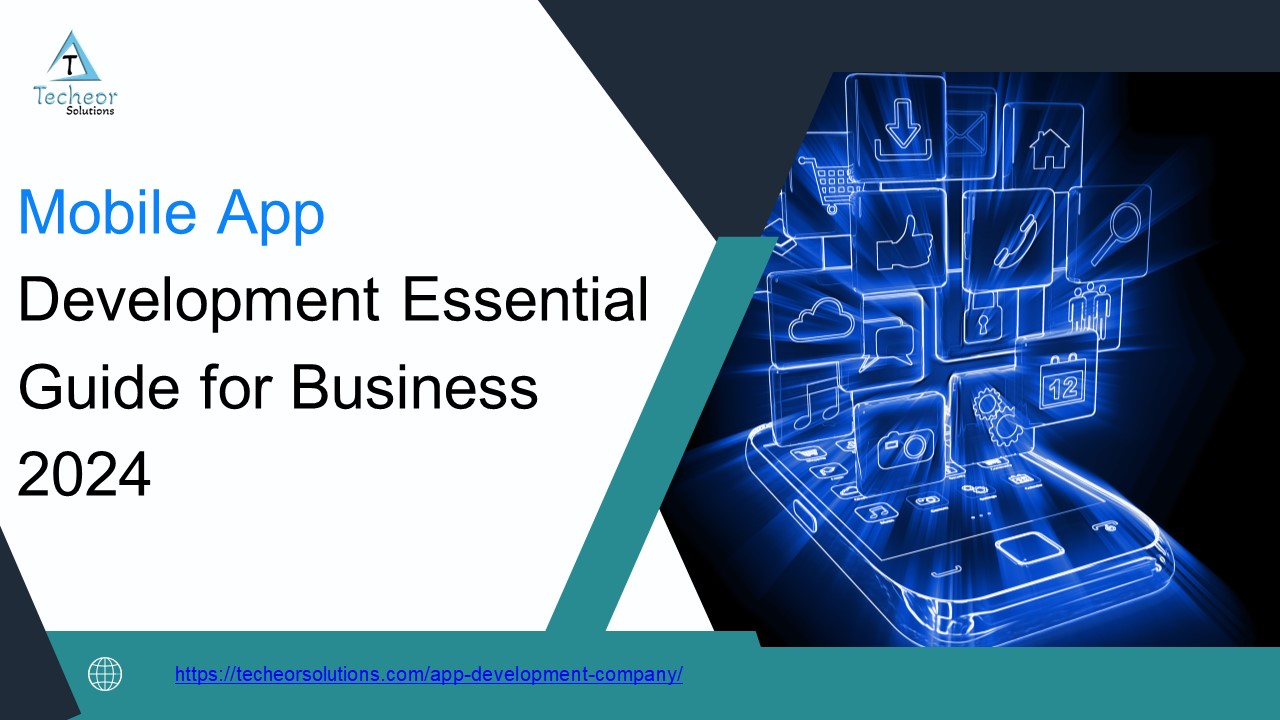Mobile App Development Essential Guide for Business 2024 - PowerPoint PPT Presentation
Title:
Mobile App Development Essential Guide for Business 2024
Description:
Unleash the power of mobile in 2024! Our guide reveals the secrets of successful business app development. Learn the key steps, explore design trends and learn how to win over customers with your mobile strategy. – PowerPoint PPT presentation
Number of Views:1
Title: Mobile App Development Essential Guide for Business 2024
1
Mobile App Development Essential Guide for
Business 2024
2
Introduction
Hello and welcome to the discussion, Mobile App
Development Essential Guide for Business 2024.
We'll discuss important actions and things to
think about in this guide for companies planning
to build a mobile app in 2024. Whatever the size
of your company, a well-thought-out and
functional mobile app can boost consumer
interaction, creating brand awareness. and
promotes business expansion
3
Understanding Mobile App Development
The process of developing software applications,
particularly for mobile platforms, such tablets
and smartphones, is known as mobile app
development. It involves several processes,
including ideation, design, development, testing
and deployment. With increasing dependence on
mobile technology, businesses must understand the
importance of mobile app development in today's
digital landscape.
4
Why Invest in Mobile App Development?
Investing in mobile app development offers many
benefits to businesses. Mobile apps provide a
direct channel for interaction with customers,
allowing personalized communications and targeted
marketing strategies. Additionally, mobile apps
can improve brand loyalty and customer retention
by providing convenient access to products and
services. Additionally, mobile apps enable
businesses to leverage smartphone capabilities
such as location-based services and push
notifications to enhance the user experience.
5
Key Points for Mobile App Development
Businesses should think about a few important
aspects before starting a mobile app development
project. These include defining the app's purpose
and target audience, choosing the right platform
(iOS, Android, or both), selecting the
appropriate development approach (native, hybrid,
or cross-platform), and establishing a realistic
budget and timeline for the project.
6
Mobile App Development Process
The mobile app development process typically
consists of several stages, including planning,
design, development, testing, and deployment.
During the planning phase, businesses define the
objectives, features, and functionality of the
app. The design phase includes creating
wireframes, user interface (UI) design, and
prototyping. Development involves coding the
frontend and backend components of the app, while
testing ensures its functionality, usability, and
security. Finally, deployment involves launching
the app on the app store and promoting it to
users.
7
Choosing the right development approach
When it comes to mobile app development,
businesses have multiple development approaches
to choose from, including native, hybrid, and
cross-platform development. Native development is
creating unique applications utilizing
platform-specific programming languages
(Java/Kotlin for Android, Swift/Objective-C for
iOS) for each platform (iOS and Android). Hybrid
development uses web technologies (HTML, CSS, and
JavaScript) to create a single codebase that can
be deployed on multiple platforms. Cross-platform
development frameworks like React Native and
Flutter allow businesses to build native-like
apps using a single codebase.
8
Designing User Experience (UX)
User experience (UX) design plays a vital role in
the success of a mobile app. Businesses should
focus on creating intuitive, user-friendly
interfaces that prioritize usability and
accessibility. This includes designing clear
navigation paths, optimizing screen layouts for
different device sizes, and incorporating
feedback mechanisms to gather user input and
improve the app over time.
9
Testing and Quality Assurance (QA)
Testing is an integral part of the mobile app
development process, ensuring that the app meets
quality standards and performs as expected on
different devices and operating systems.
Businesses should conduct extensive testing,
including functional testing, usability testing,
performance testing, and security testing, to
identify and resolve any bugs or issues before
launching an app to the public.
10
App Store Submission and Launch
Once the app is developed and tested, businesses
must prepare it to submit it to app stores (Apple
App Store, Google Play Store) for review and
approval. This includes creating an App Store
listing, including app descriptions, screenshots,
and promotional assets, and adhering to App Store
guidelines and requirements. Upon approval, the
app can be launched to users, and businesses can
begin promoting it through marketing campaigns
and user acquisition strategies.
11
Launching app
After launching an app, businesses should
continue to monitor its performance and collect
feedback from users to identify areas for
improvement. This may include releasing updates
and new features based on user feedback and
market trends, as well as resolving any technical
issues or bugs that arise. Additionally,
businesses should implement strategies to engage
and retain users, such as offering regular
updates, providing customer support, and
implementing app analytics to track user behavior
and app performance.
12
Conclusion
Ultimately, mobile app development provides
significant opportunities for businesses to
connect with customers, increase engagement, and
achieve business objectives. By following this
guide and carefully considering each step of the
mobile app development process, businesses can
develop successful mobile apps that meet the
needs of their target audience and contribute to
their overall success in 2024 and beyond.
13
THANK YOU































